Soccer drills for technique condition
Special goalkeeper training
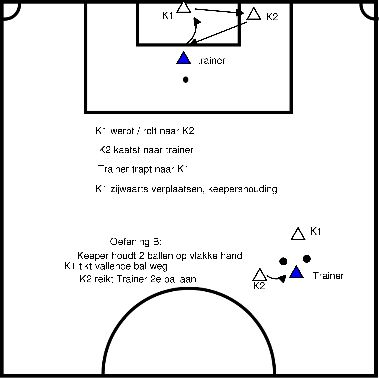
Special goalkeeper training
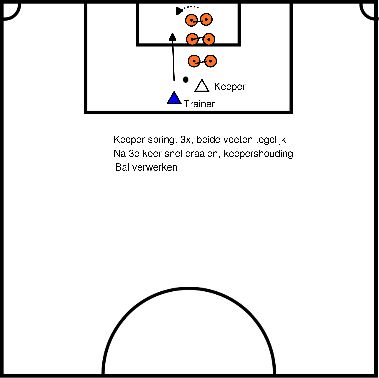
Special goalkeeper training
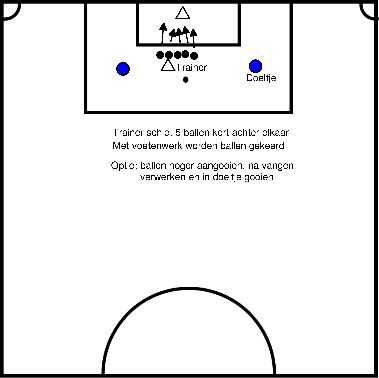
Special goalkeeper training
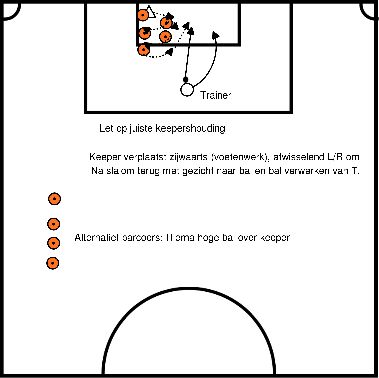
Special exercise for goalkeeper
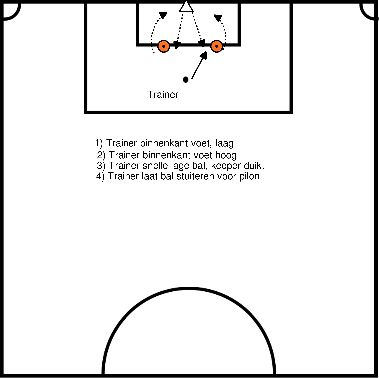
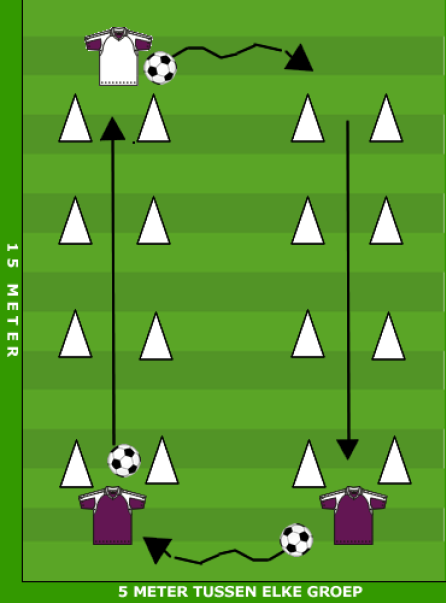
Field position:
Line up 2 x 4 x 2 pawns side by side to create two streets of pawns.
How to play:
Players must try to pass exactly through the street of pawns and then sprint through it chasing the ball. Another player (white) receives the ball and dribbles to the other street. There this player does exactly the same towards player 3.
Player 3 starts again on the same spot as player 1.
Rules of play:
- The ball must go through the street of pawns.
- If you hit a pawn, you must sprint to set it straight and try again.
- The ball must pass all cones before the receiving player can receive it.
- Make a square of 20 by 20 meters.
- Have half of your players (A) with ball scattered on the outside of the square.
- Have the other half of your players (B) stand in the middle of the square, without ball.
Execution:
- Players B move around the middle area and by calling ask for the ball a players A.
- Player A plays the ball to player B, who does the desired action and passes it back to player A.
- Player A must always stand on his toes to make the pass.
- Player B must accelerate slightly when asking for the ball (to outrun a defender in a normal game).
- The tempo is medium to high so you have to switch within 45 seconds and 60 seconds, B to outside, A to inside. You can switch multiple times and have the players make different actions.
quality:
- Each pass should be high quality and accurate.
- Players in the middle must speed up their pace when they get into the ball.
- Players on the side are always on their toes.
- As the difficulty increases, the quality must remain high.
- All balls must stay in the square.
- Don't forget to encourage successes!
Progress
- Build up skills, e.g. 1st time for each group hit 2 times
- Then 1 only hit once
- Then hit only once and play back to another outfield player
- Add a passive defender, the players inside must accelerate to shake off the defender.
- You carry out this warming-up in two lines, for example from one side to the other side of the field or around it.
Execution:
- Players walk at a jogging pace and a few feet away from the player in front of them.
- The coach or a player is leading this warm-up by calling out instructions.
- Example: Walk from sideline to sideline, the captain leads the warming-up.
- He/she shouts e.g. jump, left or right hand on the ground. Another possibility is that the captain calls out “back to feed†and at “go†the two back players sprint forward.
Quality:
- It is a joint, team warm-up. All players keep the same pace.
Progression:
- Back to front, the back players run forward
- Front to back, the front players sprint forward five meters, then walk backwards and join the back of the line.
- Have the players run five metres apart. The back player sprints forward slalomming through the other players, or the front player turns around and sprints backwards slalomming.
- Use this as a conditioning exercise towards the end of a football training session, you can do it for up to 10 minutes.
- You can add all kinds of movements to this exercise. Experiment!
- Make three lines with four to five players each.
- With pawns, make a start and end point at a distance of 10 to 15 metres from each other.
Execution:
- Have your captain lead this exercise.
- Players walk as a group, in lines of three, from the start to the end. At the end they turn around and form the same line again.
Quality:
- This exercise should be sharp and fast paced.
- Variety of activities can be done: knee up, heels buttocks, short sprints, running backwards, etc.
Progression:
- Increase speed/sharpness as players get warmed up
For this soccer practice, each 2 players are given one ball. They stand about five meters away from each other.
Execution:
- The players do each of the following exercises 10 times with each foot
- Hitting once
- Hit twice (accept and pass again)
- Volley in the feet or on the chest of the team-mate
- With the instep back to the hands or feet
- Thigh, then volley, 10 each leg.
- Chest, then volley, 10 total.
Quality:
- Players stand on their front feet each time during the drill
- All passes must be completed as accurately as possible
The players line up in a circle, ideally 6 to 8 players per circle. Per circle you have only one ball.
Execution:
One player passes the ball to another player, runs after the ball towards the player he plays in â€" the second player receives the ball and plays it again to another player from the circle, he too runs after the ball again towards the player he just played in. This keeps repeating itself.
Quality:
- Passes must be clear and accurate.
- The passes are played over the ground, keep the ball low!
- Just after the pass, the players accelerate (short sprint)
- The players call out the name of the player they want to play in
- All players are constantly on their toes, not flat footed, this is to improve handling speed.
Progression:
- You can make the game more difficult by applying one hit
- You can play with two balls
- Split your team into three teams of four
- 1 ball per team
Implementation:
- Players play the ball around within their team of four in the marked area
Quality:
- Players keep moving constantly, with many tempo changes to find space.
- Each team must try to maintain a diamond shape
- Players should all communicate with teammates, asking for the ball and calling out the name of the player by the person passing the ball
- Passes should arrive well, in space or at the feet.
- Players may not touch each other, nor may the balls touch each other.
- This drill requires great attentiveness from the players.
Progression:
- Limit the number of touches to one or two.
- Add a passive defender who can defend every ball.
- Add a defender who may conquer the ball.








